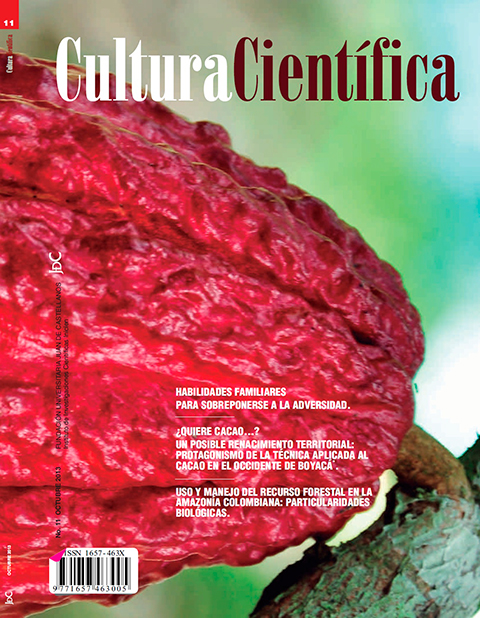Keywords:
white collared peccary, primary forest, secondary forest, habitat use.Abstract
The aim of this study was to compare the use made by peccaries (Pecari tajacu) in relation to the type of forest cover, the primary forest and secondary forest at the Biological Station "La Selva" of Costa Rica. In each type of forest cover was made: saíno counting footprints along the trails, and 25 plots were established to measure the removal of litter, and the consumption of fruits and plants of the species. In the secondary forest was observed an average of 5.34 tracks / km (SD = 1.65) and in seven plots were found litter removal. In the primary forest footprints were observed 6.82 / km (SD = 7.93), eight plots with litter removal and one with fruit consumption signals. No significant differences in habitat use.Downloads
References
ARANDA M. 2000. Huellas y otros rastros de los mamíferos grandes y medianos en México. Instituto de Ecología A.C. y la Comisión Nacional para el conocimiento y Uso de la Biodiversidad 212pp
CHAPMAN, C. & CHAPMAN, L.J. 2000. Determinants of group size in primates: the importance of travel costos. In: BOINSKI, S. & GARBER, P (eds.), On the move: how and why animals travel in groups. University of Chicago. 24-42.
FRAGOSO, J., SELVIUS, K. & VILLALOBOS, M. 2000. Wildlife management at the Rio das Mortes Xavante Reserve M.T, Brazil: Integrating indigenous culture and scientific method for Conservation. World Wildlife Fund-Brazil, Brasilia, Brazil.
JACKY, J. & OLIVER, H. 1999. Seasonal variation of home range of collared peccary in tropical rain forests of French Guiana. Journal Wildlfe of Management 63 (2): 546-552.
JHONSON D.H. 1980. The comparasion of use and availability measurements for evaluating resource preference. Ecology 61:65-71
KUPREWICZ, E. 2010. The effects of large terrestrial mammals on seed fates, Hoarding, and seedling survival in a Costa Rican Rain Forest. Tesis de doctorado Universidad de Miami, Coral Gables-Florida.
MANDUJANO, S., GALLINA, S., ACERO, G. y PÉREZ.JIMÉNEZ L. 2004. Variación estacional del uso y preferencia de los tipos vegetacionales por el venado cola blanca en un bosque tropical de Jalisco. Acta Zoológica México (n.s.) 20:45-67.
McCOY, M., VAUGHAN, C. RODRÍGUEZ, R. & KITCHEN, D. 1990. Seasonal movement, home range, activity and diet of collared peccaries (Tayassu tajacu) in Costa Rican dry forest. Vida Silv. Neotrop., 2: 6-20.
MONTERO, A. 2007. Densidad, uso de hábitat y movimiento especial de los pecaríes (Tayassu pecari y Pecari tajacu) en la Estación Sirena, Parque Nacional Corcovado, Costa Rica.
OIMT (Organización Internacional de las Maderas Tropicales). 2002. Directrices de la OIMT para la restauración, ordenación y rehabilitación de bosques tropicales secundarios y degradados 87pp.
QUIJANO, E.H. 2000. Ecología, aprovechamiento y conservación de la fauna silvestre en Tres Reyes; Quintana Roo. Tesis de maestría. ECOSUR (El Colegio de la Frontera Sur). Cherumal, Quintana Roo, México.
REYNA-HURTADO, R., & TANNER, G. 2005. Habitat Preferences of Ungulates in Hunted and Nonhunted Areas in the Calakmul Forest, Campeche, México.
REYNA-HURTADO, R., ROJAS-FLORES, E. y TANNER, G. 2009. Home range and habitat preferences of white-lipped peccaries (Tayassu pecari) in Clakmul, Campeche, México. Journal of Mammalogy 90(5):1199-1209.
TORREALBA, I. 1993. Ecología de los grupos de saínos (T. tajacu) y daños que ocasionan en los cultivos vecinos a la Estación Biológica la Selva, Costa Rica. Tesis de Maestría. Programa Regional de Maestría en Vida Silvestre.
SUARÉZ, I. 1993. Ecología de los grupos de saínos (Tayassu tajacu) y daños que ocasionan en los cultivos vecinos a la Estación Biológica La Selva, Costa rica.
SOWLS, L. K. 1984. The Pecaríes. The University of Arizona Press, Tucson, Arizona, 251pp
CHAPMAN, C. & CHAPMAN, L.J. 2000. Determinants of group size in primates: the importance of travel costos. In: BOINSKI, S. & GARBER, P (eds.), On the move: how and why animals travel in groups. University of Chicago. 24-42.
FRAGOSO, J., SELVIUS, K. & VILLALOBOS, M. 2000. Wildlife management at the Rio das Mortes Xavante Reserve M.T, Brazil: Integrating indigenous culture and scientific method for Conservation. World Wildlife Fund-Brazil, Brasilia, Brazil.
JACKY, J. & OLIVER, H. 1999. Seasonal variation of home range of collared peccary in tropical rain forests of French Guiana. Journal Wildlfe of Management 63 (2): 546-552.
JHONSON D.H. 1980. The comparasion of use and availability measurements for evaluating resource preference. Ecology 61:65-71
KUPREWICZ, E. 2010. The effects of large terrestrial mammals on seed fates, Hoarding, and seedling survival in a Costa Rican Rain Forest. Tesis de doctorado Universidad de Miami, Coral Gables-Florida.
MANDUJANO, S., GALLINA, S., ACERO, G. y PÉREZ.JIMÉNEZ L. 2004. Variación estacional del uso y preferencia de los tipos vegetacionales por el venado cola blanca en un bosque tropical de Jalisco. Acta Zoológica México (n.s.) 20:45-67.
McCOY, M., VAUGHAN, C. RODRÍGUEZ, R. & KITCHEN, D. 1990. Seasonal movement, home range, activity and diet of collared peccaries (Tayassu tajacu) in Costa Rican dry forest. Vida Silv. Neotrop., 2: 6-20.
MONTERO, A. 2007. Densidad, uso de hábitat y movimiento especial de los pecaríes (Tayassu pecari y Pecari tajacu) en la Estación Sirena, Parque Nacional Corcovado, Costa Rica.
OIMT (Organización Internacional de las Maderas Tropicales). 2002. Directrices de la OIMT para la restauración, ordenación y rehabilitación de bosques tropicales secundarios y degradados 87pp.
QUIJANO, E.H. 2000. Ecología, aprovechamiento y conservación de la fauna silvestre en Tres Reyes; Quintana Roo. Tesis de maestría. ECOSUR (El Colegio de la Frontera Sur). Cherumal, Quintana Roo, México.
REYNA-HURTADO, R., & TANNER, G. 2005. Habitat Preferences of Ungulates in Hunted and Nonhunted Areas in the Calakmul Forest, Campeche, México.
REYNA-HURTADO, R., ROJAS-FLORES, E. y TANNER, G. 2009. Home range and habitat preferences of white-lipped peccaries (Tayassu pecari) in Clakmul, Campeche, México. Journal of Mammalogy 90(5):1199-1209.
TORREALBA, I. 1993. Ecología de los grupos de saínos (T. tajacu) y daños que ocasionan en los cultivos vecinos a la Estación Biológica la Selva, Costa Rica. Tesis de Maestría. Programa Regional de Maestría en Vida Silvestre.
SUARÉZ, I. 1993. Ecología de los grupos de saínos (Tayassu tajacu) y daños que ocasionan en los cultivos vecinos a la Estación Biológica La Selva, Costa rica.
SOWLS, L. K. 1984. The Pecaríes. The University of Arizona Press, Tucson, Arizona, 251pp
Downloads
Published
2018-08-01
How to Cite
Berrondo, L., Arroyo Arce, S., Canto, Y., Carrillo, N., Gómez Carrillo, V., Loaiza, C., … Unda, K. (2018). Living conditions of sainos (Pecari tajacu) in two types of trainforests in the station “la selva”, located in Costa Rica. Cultura científica, (11), 32–39. Retrieved from https://revista.jdc.edu.co/Cult_cient/article/view/169
Issue
Section
Article of scientific and technological research





